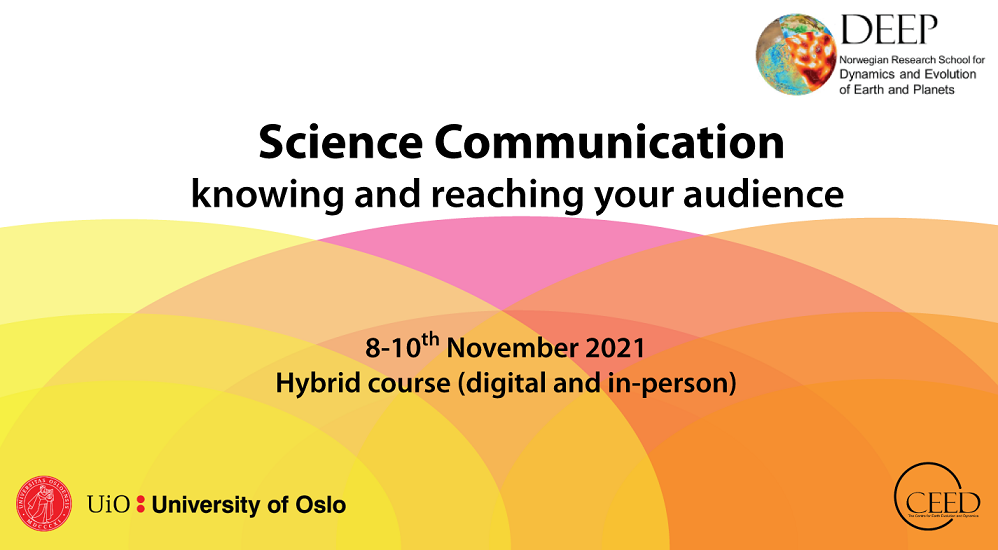For this course, we have an exciting line-up of science communicators, including scientists, journalists, authors, artists, poets, and social media coordinators. They will share their personal and professional experiences in science communication, and provide tips for getting your own work out there. Our guest lecturers (also in-person or online) include those from the University of Oslo and internationally. The three half-day sessions will include a combination of lectures, discussions, group work and activities. Students will need to prepare two tasks in advance of the course (listed below).
Course description
Scientific communication is at the critical interface of science and society. Without the (successful) dissemination of scientific results, and the conversations around them, not only does the science fail, but so too does the forward progression society. A sound foundation in communication is applicable for both basic and applied research topics, teaching environments, as well as in the science-meets-policy spheres.
As at 2021, communication is manifest in a multitude of realms and options; from in-person formats such as dinner-time conversations or major public speaking events, to digital formats such as press releases, social media posts, and non-fiction works. In spite of, and arguably in part due to, this myriad of options, many scientists do not know how to best transfer their knowledge more widely.
There are many different considerations at play, for example; language barriers, including those surrounding inherently scientific concepts such as uncertainty or risk; a lack of formal education on the outreach and diversity topics; a variable or unfamiliar target audience; a highly “specialized” topic; and even individual scientist personalities and predisposition.
This short course takes the approach that science communication is for every scientist and there are some fundamental tools that should be kept in mind in order to maximise the reach, impact and legacy of their work.
Application process
Apply within 21 October 2021 through our online application form.
Maximum number of participants 15 persons. We strongly recommend you register as soon as possible.
This course is devoted to PhD candidates who are members of DEEP as the top priority group, but If there are still some available spots after deadline, other members and staff at the Department of Geosciences, UiO are welcome to apply. We have 15 places in the course and DEEP members will have first priority
Course delivery
This is a hybrid course (online and in-person). we will run the course in 3 half days (12 - 16 hours) 10-15h, Hybrid form. We strongly encourage DEEPs PhD candidates to participate in the course in-person in Oslo. DEEP will cover flight and accommodation expenses for them.
Pre-course student activities:
Enrolled students are encouraged to submit a short press release and/or blog piece or similar in advance of the course for some feedback and iterations during the week. In advance of the course, all student attendees have two assignments:
Task 1: All students should prepare a short (max. 1 page with 400 words) sample of writing in the form of a press-release or blog post. A template will be provided via email before the course. On day one the students will be divided into smaller groups and share their work with each other. Each student will then read their group members’ writing samples for feedback during a second group session on day two or day three.
Task 2: During the week all students will work on creating an original image for scientific outreach. The image does not need to be generated in advance of the course but we encourage you to come with an idea about what you will create e.g. a summary image of your research, or a key geoscience process/concept that you would like to create, or an art-meets-science image. After the course, students will be invited to contribute their image to the brand new “s-Ink” image repository - which will be explained during the week.
The lecturers
- Grace Shephard - University of Oslo (CEED), Norway
- Elodie Chabrol - Pint of Science, France
- Fabio Crameri - University of Oslo (CEED), Norway
- Hazel Gibson - European Geosciences Union (EGU), Germany
- Philip Heron - University of Toronto, Canada
- Sam Illingworth - Edinburgh Napier University, U.K.
- Anne Hope Jahren - University of Oslo (CEED), Norway
- Karen Mair - University of Oslo (NJORD), Norway
- Henrik Svensen - University of Oslo (CEED), Norway
- Eivind Torgersen - Titan.uio.no, University of Oslo, Norway
- Paul Voosen - Science Magazine, U.S.A.
